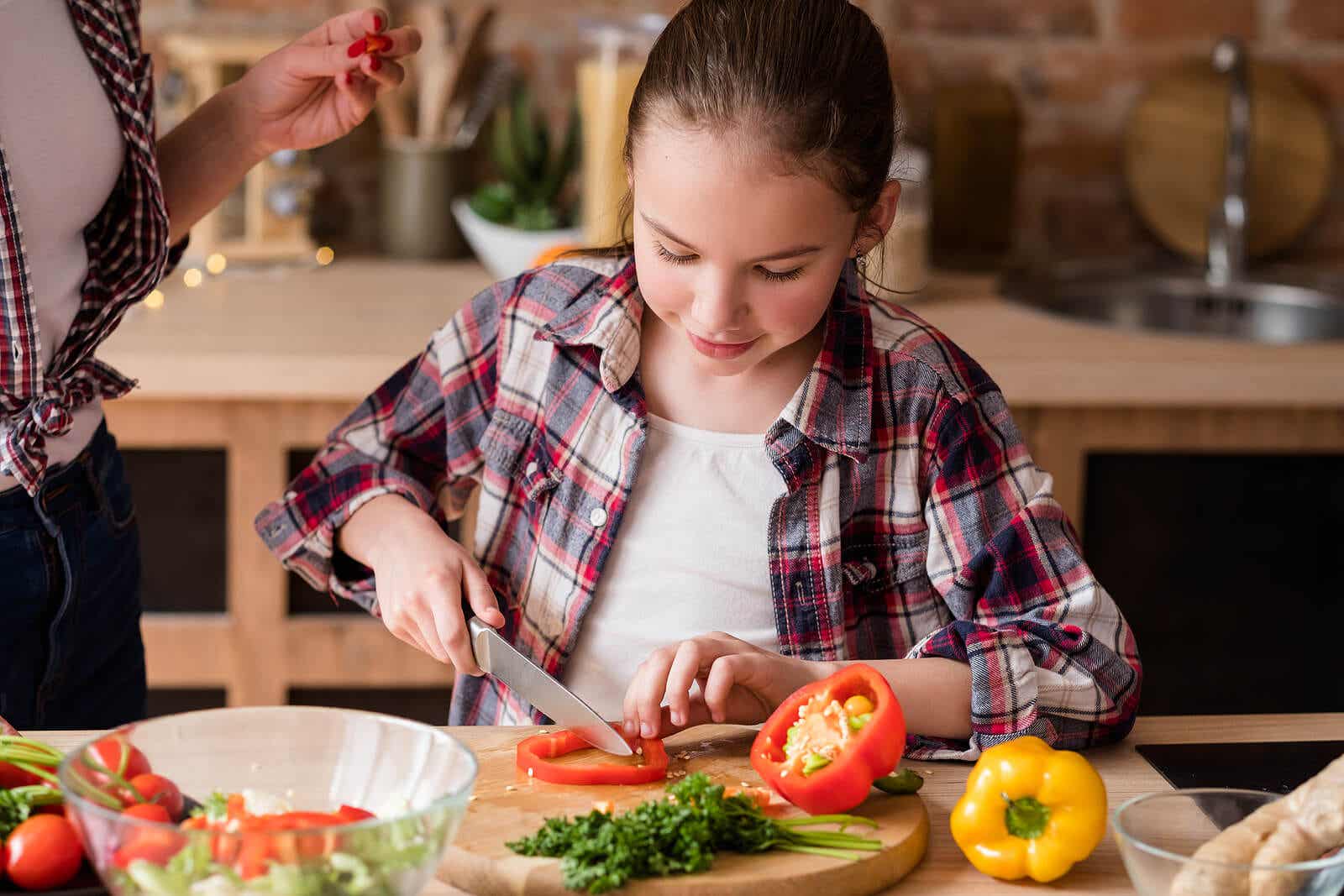How to Increase Children's Intake of Vegetables

Every parent assumes that their children hate vegetables, so they avoid generating conflict at the dinner table by not offering them. But, if you don’t try, how will you know if they like them, given that they’ve never tried them? For this reason, we’re going to reveal how to increase children’s intake of vegetables without them noticing.
Even if it’s difficult to give them vegetables for the first time, it’s important for parents to have patience and vary the way these are cooked and presented. You should even eat them yourselves, as little ones learn by imitation and you’re their main example to follow.
Did you know that forcing them to eat vegetables increases their rejection of them? Or that rewarding them with dessert generates an emotional bond between the two foods?

Why is it important to eat vegetables every day from an early age?
The Public Health Agency in Spain, the World Health Organization (WHO), and other nutrition associations agree that vegetables are the basis of nutrition. They provide hardly any calories, as they have a high water, vitamin, and mineral content. In addition, they’re rich in fiber, which is very satiating, meaning they help to regulate appetite and reduce the consumption of unhealthy foods.
Given their richness in the nutrients mentioned above, they reduce the risk of obesity, colorectal cancer, and digestive disorders, such as constipation.
In addition, the vitamins and minerals they contain are antioxidants, so they protect cells and skin from stress and damage caused by external aggressions, such as viruses, bacteria, and radiation.
How to increase children’s intake of vegetables?

How to cook vegetables?
First of all, make sure that the pieces are equal in size. This will ensure that they’re tender when cooked. And, if you also use herbs and spices, you’ll obtain a tasty meal. Also, try not to mix several vegetables in the same dish or too many colors (1-2 is enough). A good option is to mix them with foods your kids already like, such as pasta and rice.
Regarding cooking techniques, alternate between baking, steaming, sautéing, mashing… And use them as secondary ingredients in quiches or omelets, as part of a sauce or a filling.
Have you tried cutting them into thin slices and toasting them on both sides as if they were chips? Accompanied with a yogurt sauce, hummus, or any vegetable pate, they’re very popular.
Mini-chefs for a day, the practical way to consuming vegetables
Take advantage of their increased interest in cooking to let them decide what to eat, by looking in recipe books for children and participating in the cooking of vegetables. This is the way to make them want to try them, as studies carried out in schools have shown.
Have you ever thought of dedicating some time during the week to cooking dishes from another country? It can be a way for them to learn about world gastronomy. You can choose those in which vegetables are the main characters, such as Indian or Greek cuisine, or look for vegetarian recipes.
A rainbow on the plate is a way to increase the intake of vegetables easily
This consists of choosing vegetables by color and alternating them throughout the day and the week. Your kids will eat them without realizing it! Do it together every week and, based on the vegetables chosen, plan your dishes. To keep track of which vegetables have been served, draw up a table and mark them with a circle.

Go to a vegetable garden or grow plants at home
This will help them understand the whole process and the path they take to get to the market or the store. It’ll also help your kids get to know the origin of different vegetables and discover the tasks needed for them to grow, such as planting the seeds and watering them.
The importance of increasing the intake of vegetables
As you’ve seen, involvement in meal planning and preparation is key to increasing the intake of vegetables, but more importantly, they must see you and others eating them.
Moreover, it’s not only a matter of serving vegetables at main meals but also between meals as a snack. And, if your children show some resistance, offer them at least 15-20 times, and in different ways.
Finally, we remind you that at least one of the portions should be raw, so the best thing you can do is to use a good vinaigrette as dressing.
Every parent assumes that their children hate vegetables, so they avoid generating conflict at the dinner table by not offering them. But, if you don’t try, how will you know if they like them, given that they’ve never tried them? For this reason, we’re going to reveal how to increase children’s intake of vegetables without them noticing.
Even if it’s difficult to give them vegetables for the first time, it’s important for parents to have patience and vary the way these are cooked and presented. You should even eat them yourselves, as little ones learn by imitation and you’re their main example to follow.
Did you know that forcing them to eat vegetables increases their rejection of them? Or that rewarding them with dessert generates an emotional bond between the two foods?

Why is it important to eat vegetables every day from an early age?
The Public Health Agency in Spain, the World Health Organization (WHO), and other nutrition associations agree that vegetables are the basis of nutrition. They provide hardly any calories, as they have a high water, vitamin, and mineral content. In addition, they’re rich in fiber, which is very satiating, meaning they help to regulate appetite and reduce the consumption of unhealthy foods.
Given their richness in the nutrients mentioned above, they reduce the risk of obesity, colorectal cancer, and digestive disorders, such as constipation.
In addition, the vitamins and minerals they contain are antioxidants, so they protect cells and skin from stress and damage caused by external aggressions, such as viruses, bacteria, and radiation.
How to increase children’s intake of vegetables?

How to cook vegetables?
First of all, make sure that the pieces are equal in size. This will ensure that they’re tender when cooked. And, if you also use herbs and spices, you’ll obtain a tasty meal. Also, try not to mix several vegetables in the same dish or too many colors (1-2 is enough). A good option is to mix them with foods your kids already like, such as pasta and rice.
Regarding cooking techniques, alternate between baking, steaming, sautéing, mashing… And use them as secondary ingredients in quiches or omelets, as part of a sauce or a filling.
Have you tried cutting them into thin slices and toasting them on both sides as if they were chips? Accompanied with a yogurt sauce, hummus, or any vegetable pate, they’re very popular.
Mini-chefs for a day, the practical way to consuming vegetables
Take advantage of their increased interest in cooking to let them decide what to eat, by looking in recipe books for children and participating in the cooking of vegetables. This is the way to make them want to try them, as studies carried out in schools have shown.
Have you ever thought of dedicating some time during the week to cooking dishes from another country? It can be a way for them to learn about world gastronomy. You can choose those in which vegetables are the main characters, such as Indian or Greek cuisine, or look for vegetarian recipes.
A rainbow on the plate is a way to increase the intake of vegetables easily
This consists of choosing vegetables by color and alternating them throughout the day and the week. Your kids will eat them without realizing it! Do it together every week and, based on the vegetables chosen, plan your dishes. To keep track of which vegetables have been served, draw up a table and mark them with a circle.

Go to a vegetable garden or grow plants at home
This will help them understand the whole process and the path they take to get to the market or the store. It’ll also help your kids get to know the origin of different vegetables and discover the tasks needed for them to grow, such as planting the seeds and watering them.
The importance of increasing the intake of vegetables
As you’ve seen, involvement in meal planning and preparation is key to increasing the intake of vegetables, but more importantly, they must see you and others eating them.
Moreover, it’s not only a matter of serving vegetables at main meals but also between meals as a snack. And, if your children show some resistance, offer them at least 15-20 times, and in different ways.
Finally, we remind you that at least one of the portions should be raw, so the best thing you can do is to use a good vinaigrette as dressing.
All cited sources were thoroughly reviewed by our team to ensure their quality, reliability, currency, and validity. The bibliography of this article was considered reliable and of academic or scientific accuracy.
- Agencia de Salud Pública de Cataluña. (2017) La alimentación saludable en la etapa escolar.
- Aitor Sánchez y Lucía Martínez. ¿Qué le doy de comer? Una guía para que los más pequeños coman de forma saludable. 2019. Ed. Paidós.
- Savoie-Roskos, M R; Wengreen, H; Durward, C (2016) Increasing fruit and vegetable intake among children and youth through Gardening-Based Interventions: A Systematic Review. J Acad Nutr Diet, 117(2): 240-50.
- Folkvord, F (2019) Systematically testing the effects of promotion techniques on children’s fruit and vegetables intake on the long term: a protocol study of a multicenter randomized controlled trial. BMC Public Health, 19(1): 1578.
- Osborne, C L; Forestell, C A (2012) Increasing children’s consumption of fruit and vegetables: does the type of exposure matter? Physiol Behav, 106(3): 362-8.
This text is provided for informational purposes only and does not replace consultation with a professional. If in doubt, consult your specialist.








